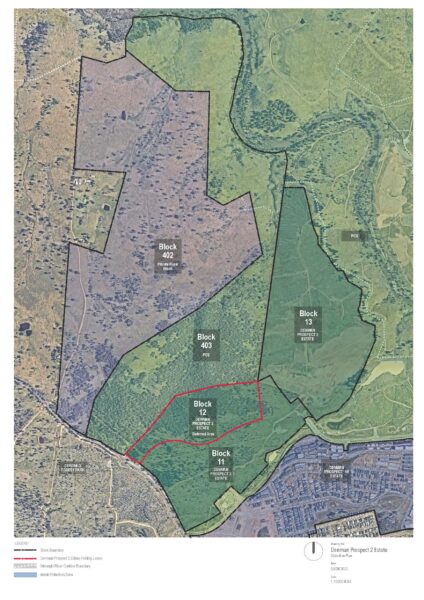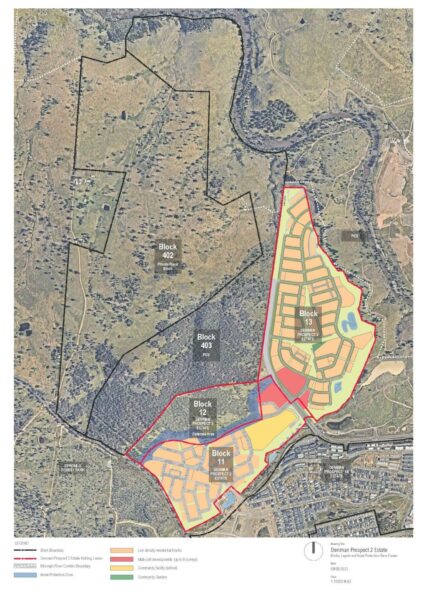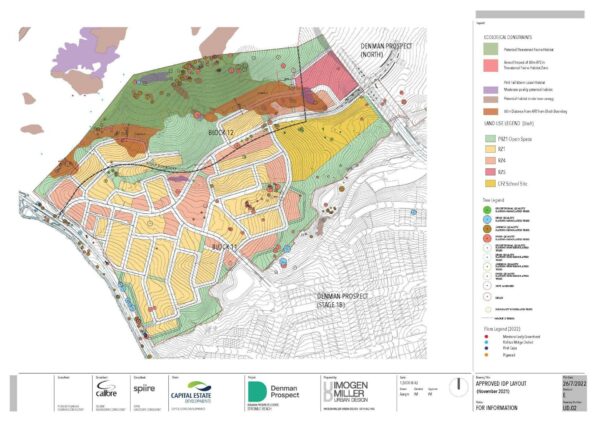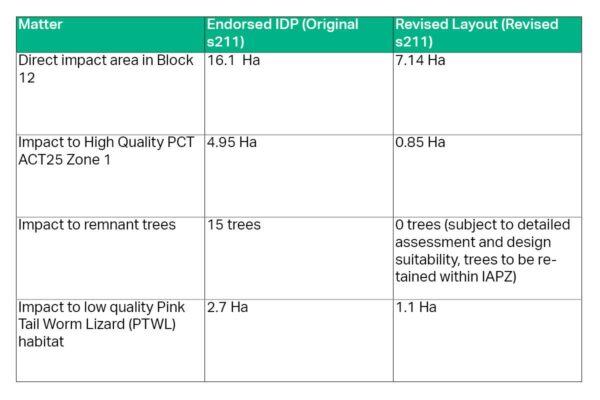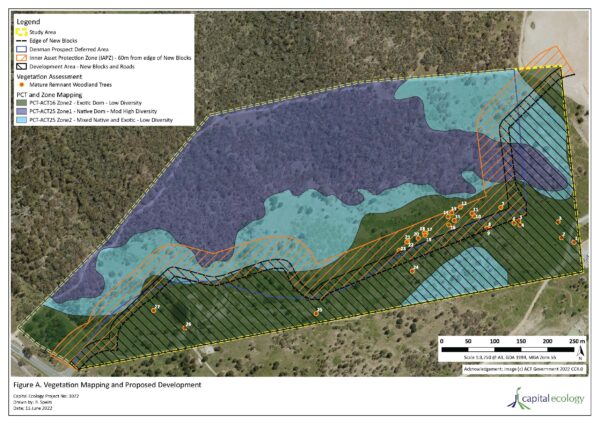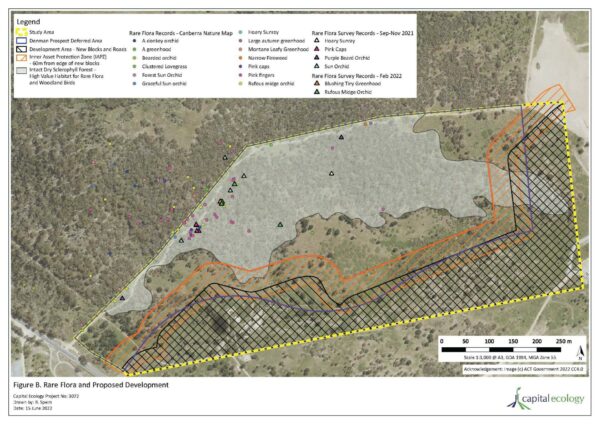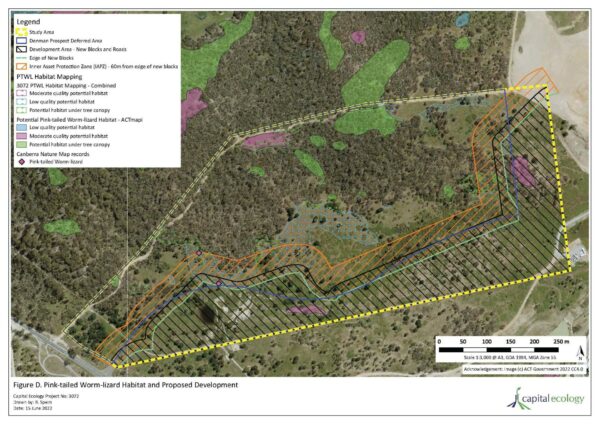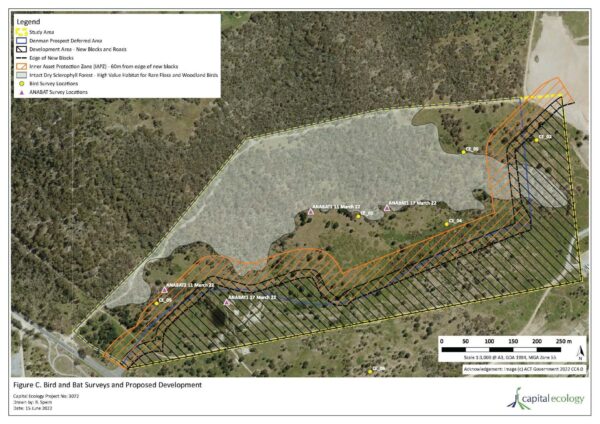The proposal
Capital Estate Developments (CED) is working on a subdivision proposal (Estate Development Plan Development Application) on land that includes Block 12 Denman Prospect and parts of the adjoining Block 11. This area will form the remaining component of the Molonglo Stage 2 development footprint in Denman Prospect. The Estate Development Plan (EDP) Development Application (DA) will be for the infrastructure works to support residential and urban development (which includes creation of blocks to provide approximately 850 dwellings and for development, roads, services and open space).
Site and background
The area that is the subject of this application is Block 12 Section 1 at Denman Prospect. It is within the Molonglo Valley Future Urban Area and is notionally zoned for residential development (Figures 1 and 2 show the site). This block is referred to as the ‘Deferred Area’ because planning decisions in relation to it were ‘deferred’ in 2013. Irrespective of this, the ACT Government sold Capital Estate Developments a holding lease for Blocks 11 and 12 Denman Prospect in 2018, for the purpose of urban development. A holding lease is a form of Crown Lease that requires certain conditions (set out in a Deed of Agreement) to be met prior to consequent longer term Crown Leases being granted.
|
Figure 1: Locational Context Plan |
Figure 2: Site Context |
This Section 211 application sits within a context of many other existing planning and environmental approvals for Molonglo and Denman Prospect, including two other Section 211 Exemptions, these are shown in Figure 3 below. Further information on what is a Section 211 Exemption and why it is needed is provided in the FAQ section below.
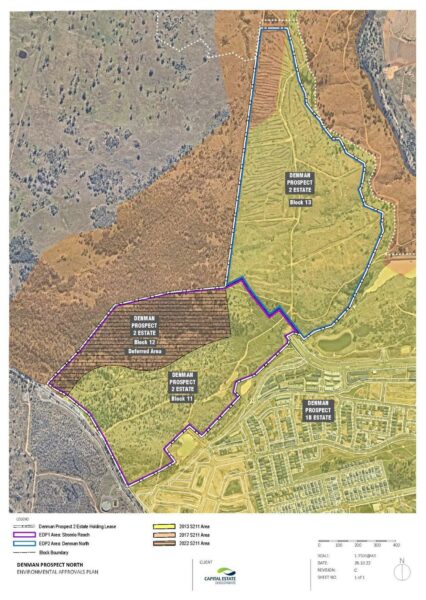 |
Draft Section 211 submission
CED submitted a draft Section 211 Exemption application to the Planning Authority in late 2021. The application was based on the Indicative Development Plan (IDP) which was endorsed by the Deed Manager in the Environment, Planning and Sustainable Development Directorate (EPSDD) and included some urban development and a 60 metre bushfire asset protection zone (APZ) within Block 12 (shown in Figure 4). This was publicly notified and CED received considerable interest in the application, with a number of submissions and comments received from the community and ACT Government Agencies which must be addressed in the revised s211 report.
|
Figure 4: IDP Layout original Section 211 Submission |
Comments and matters raised by agencies included:
- Additional clarification and details on the proposal.
- Clarification on the 2017 EIS Exemption and its relationship to the project.
- Additional Bushfire assessment.
- Further assessment of Ecological values and potential habitat for rare plants and animals.
- Updated heritage assessment.
- Public consultation.
- Need for visual impact assessment.
Matters raised by the community through submissions included:
- Questions about what the project involves and the area of impact.
- How bushfire controls will be provided and the area of impact.
- Impacts to ecological values.
- Indirect impacts to values on Block 403.
- Importance of the area for recreation and physical and mental health for residents.
- Need for further assessment.
Additional assessments and revised development layout
In response to the submissions and comments received the CED project team has undertaken additional assessments to support the revised report including ecological surveys, heritage surveys, visual assessment and bushfire assessment.
The EDP layout has been revised (refer to Figure 5) and this reduces impacts to Block 12.
The concept plan also shows trails within Block 12 to provide connectivity to the existing fire trails. The exact alignment of the trails is yet to be determined but the intention is to provide trails that link to the ridgeline in Block 12 and also provide for a loop. The approximate alignment shown indicates the intention to avoid trails in the higher value ecological areas. These trails will provide recreational amenity to the residents of Denman and they will also help to minimise the risk to environmental values by minimising uncontrolled recreation within Block 12.
The outcome of the revised layout is a substantial reduction in the direct impact area within Block 12 from 16.1 ha to 7.14 ha. The table below compares the impacts between the original s211 submission and that proposed in the revised application.
|
|
There would be no direct impacts to Block 403 to the north.
Bushfire
The bushfire assessment requires that a 60m wide Inner Asset Protection Zone (IAPZ) to be provided, and remnant trees can be retained within this area.
This proposal does not require the establishment of a Strategic Fire Advantage Zone (SFAZ) as the 60m APZ provides the required treatment to protect the residential development area. Notwithstanding, the area is already identified as an existing SFAZ area and no changes are proposed to the existing SFAZ planning or establishment undertaken to date.
Ecology
The Ecological Assessment has been updated to include the following additional work:
- Threatened orchid surveys undertaken in spring 2021 and autumn 2022
- Bird surveys undertaken in May and July 2022
- Pink Tailed Worm Lizard (PTWL) habitat mapping
- Anabat surveys undertaken in March 2022
The revised layout avoids the majority of ecological values and high quality ACT25 Zone 1 vegetation and only 0.85 ha of this will be impacted (Figure 6), and areas with records of rare plants will be avoided (Figure 7).
Based on revised PTWL mapping a total of 1.1 ha of low quality PTWL habitat will be impacted (Figure 8). Given the habitat is low quality it does not trigger further consideration under the EPBC Strategic Assessment clearing budgets.
The intention is for the 15 mature remnant trees to be retained within the APZ (subject to detailed design and suitability) as shown in Figure 6.
|
Figure 6: Vegetation Mapping and development layout |
Figure 7: Rare Flora and development layout |
|
Figure 8: PTWL Habitat and development layout |
Figure 9: Birds and Bats |
Heritage
A new Heritage Survey of the site was undertaken by a heritage consultant and the Representative Aboriginal Organisations. One archaeological object was located close to the proposed IAPZ area and indicative recreational trails, this was part of a small group of objects, of which the other items were previously salvaged. The Heritage assessment determined that there is a large cluster of dense forest that lies between the Heritage site and any proposed urban disturbance. As such the site is not at risk of indirect or inadvertent impacts and will be further reviewed at detailed design stage to ensure this remains a low risk.
There are other heritage objects and places in the area, but they are well outside the proposed development footprint.
Consultation sessions
CED has undertaken consultation activities to provide information on the updated assessments completed since the original s211 submission. The sessions have provided opportunities for questions and comments before CED submit the updated report back to the Planning Authority. As part of the consultations, CED has met with the Conservation Council and representatives from other Conservation and stakeholder Groups, presented at a Molonglo Valley Community Forum meeting, and held a community drop-in session at the Denman Village Community Centre.
Approvals process
CED resubmitted the EIS for Block 12 to EPSDD in November 2022. The EDP DA for Blocks 11 & 12 is expected to be lodged in late 2023. The EIS documentation will form part of this EDP DA which will be publicly notified. Prior to the formal lodgement of the DA, CED will undertake pre-DA public consultation in 2023 in accordance with EPSDD requirements.
FAQs
Why do we need an Environmental Assessment?
Development Applications for EDPs can be assessed in either the code track, merit track (the usual track for most DAs), or the impact track if works are likely to trigger certain significant matters or types of development, such as impacting threatened species, clearing native vegetation, registered heritage sites etc. DAs assessed in the impact track must be accompanied by an Environmental Assessment, either an Environmental Impact Statement (EIS) or a s211 Exemption.
What is a Section 211 Exemption Application?
A Section 211 application is a type of Environmental Impact Assessment that acknowledges previous assessments and seeks to avoid duplication of effort. It requires that environmental values and impacts are assessed, avoided, mitigated (and offset if required) and the application is notified to the public and relevant government agencies.
The term ‘exemption’ does not apply to the need for the proponent to seek approval on an Environmental Impact Assessment. Rather, the term ‘exemption’ only applies to the need for the proponent to prepare an EIS, which is a specific type of Environmental Impact Assessment. While the label may be misleading, a Section 211 Exemption Application is still a type of Environmental Impact Assessment, which is supported by detailed studies.
A Section 211 Exemption may be provided for projects where, if recent relevant investigations have been undertaken to identify and assess impacts, the Minister can grant an exemption from the requirement for an EIS to support the DA (as impacts have already recently been assessed).
Why do we need this Section 211 Application?
In relation to the ACT planning requirements, the adjoining Block 11 that contains most of the proposed EDP, is covered by an existing Section 211 Exemption for urban development (NI2013-338 granted in 2013), which is valid until 2041. This exemption did not cover Block 12, and ‘deferred’ decisions in relation to Block 12, as it was deemed adequate investigations had not been undertaken at that time.
Because the proposed EDP includes both blocks 11 and 12, and further ecological investigations of Block 12 were undertaken, it was determined that the appropriate way to support the EDP DA would be to seek a supplementary s211 exemption for Block 12. Then the EDP DA would be supported by two section 211 exemptions (NI2013-338 which still applies, and the exemption that is the subject of this consultation).
There is also another s211 exemption in place for this part of Molonglo Valley, (NI2017-183), but this exemption does not cover the type of works proposed as part of the EDP, it only covered bushfire management and abatement works in Block 12 and other nearby land in the Molonglo Valley.
How does The Environment Protection and Biodiversity Conservation Act 1999 (EPBC) apply to this proposal?
The EDP area (Blocks 11 and 12 Denman Prospect) was assessed as part of the EPBC Molonglo Strategic Assessment Area and is wholly covered by an EPBC Approval under the Commonwealth EPBC Act, therefore all EPBC matters of National Environmental Significance have already been addressed in relation to this land. The ecological assessments undertaken for this project have included assessment to ensure that the proposed impacts would be consistent with the EPBC Approval.
What are Strategic Fire Advantage Zones (SFAZ)?
Strategic Fire Advantage Zones (SFAZs) are part of the ACT’s ongoing Bushfire Operations Plan implemented under the ACT’s Strategic Bushfire Management Plan 2019-2024 (SBMP). The practical implementation of planned burning (also known as prescribed burning or hazard-reduction burning) focuses on establishing Strategic Firefighting Advantage Zones (SFAZs). These aim to reduce the intensity and spread of fires across large areas of landscape and contribute to the success of firefighting under moderate weather conditions. A range of treatment strategies are applied to establish SFAZs, and these are established all across the peri-urban areas of the ACT. The SBMP states that the location of SFAZs will be dynamic, not fixed, using an evidence-based approach. Standards relating to these treatments of SFAZs are identified in the ACT Bushfire Management Standards.
A SFAZ is not a requirement for the proposed urban development, but is an on-going management tool used to manage fuel across the landscape, and works to establish or manage a SFAZ within this area are not part of the proposal, but will be subject to separate development approvals (relying on the previous section 211 NI2017-183), if required.
